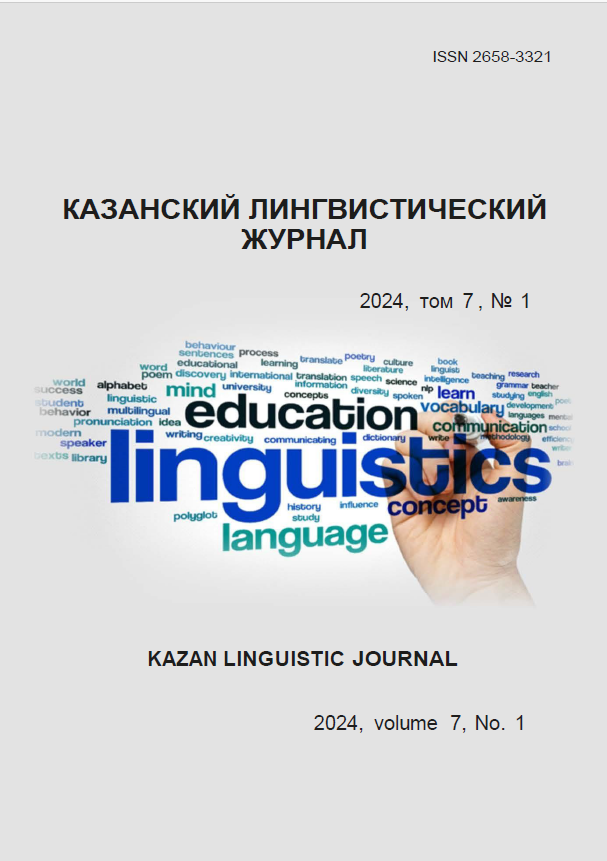An Analysis of Russian Loanwords in Persian in the Qajar Era: a Case Study of “Khosrow Mirza’s Travelogue to St. Petersburg”
https://doi.org/10.26907/2658-3321.2024.7.1.60-71
Keywords:
Russian loanwords, travelogue, Khosrow Mirza, Iran, RussiaAbstract
One of the most important factors of language dynamics is the adoption of borrowed words that enter another language under the influence of political, economic, cultural relations, etc. Persian is no exception to this provision, and many words have been borrowed into this language, especially from European languages. The Russian language was widely used in Iran from the time of Fath-Ali Shah to the end of the Qajar era. The article analyzes Russian loanwords that entered the Persian language during the reign of the Qajars, that is, from the end of the XVIII century. to the beginning of the XX century. To this end, we examined the travelogue of Khosrow Mirza, the 16-year-old heir to the Iranian throne, about a trip to St. Petersburg. Since the sources related to the entry of Russian loanwords into Persian language are very limited and many Russian loanwords are wrongly mentioned as a French loanword in the dictionaries, this work can help to determine the nature of many words. This study showed that due to the Iran-Russia wars and the subsequent increase in Russia's economic influence in Iran, most of the loans used at this time are related to the military and commercial fields.
References
References
Zorina A.V. English-language loan words in modern Russian (by the example of the internet vocabulary). Kazan linguistic journal. 2018;1(2(1)):5–14. URL: http://ttt.kaz-linguo-journal.ru/index.php/linguo/article/view/173/154 [accessed: 23.10.2023].
Bashiri I. Russian Loanwords in Persian and Tajiki. In Marashi M, editor, Persian Studies in America. Bethesda, Md: Iran books; 1994. p. 109–141. URL: https://www.academia.edu/10442551/Russian_Loanwords_in_Persian_and_Tajiki_Languages [ac-cessed: 09.10.2023].
Mohammadi M. Abdaltajedini N. Survey of Russian Loanwords in Persian Lan-guage: Case Study on Farhang–e Bozorg-e Sokhan. LRR 2013;4(3):155–178. (In Persian.)
Peisikov L.S. Lexicology of the modern Persian language. M.: Ed. Moscow State University; 1975. (In Russ.)
Кulagina L.М. Russia and Iran (XIX – beginning of XX century. Мoscow: Kluch-С Publ; 2010. (In Russ.)
Ter-Oganov N.K. Persian Cossack Brigade, 1879–1921. M.: Institute of Oriental Studies; 2012. (In Russ.)
Sadeghi A. Russian origin words in Persian and their history. Journal of Linguistics. 2005;20(2):3–46. (In Persian.)
Modarresi Y., Samei H., and Safavi Mobarhen Z. The Lexicon of the Expressions of the Qajar Period: Army and Military. Tehran: Daftar-e Pajuheshaye Farhangi; 1991. (In Persian.)
Hale F. From Persian Uplands. New York; 1920. 247 p.
Adamiyat F. Amir Kabir and Iran. Tehran: Khwarizmi; 1969. (In Persian.)
Masoudi A. History of printing in Iran. Library research and academic information. 2000;32(35):61–75. (In Persian.)
Ananich B.V. Banking Houses in Russia, 1860–1914. Leningrad: Nauka; 1991. (In Russ.)
Marvin L. Entner. Russo-Persian commercial relations 1828–1914. Flor.: University of Florida; 1965.
Afshar M. Khosrow Mirza's travelogue to Saint Petersburg. Tehran: Ketabkhaneh-ye Mostowfi; 1970. (In Persian.)






